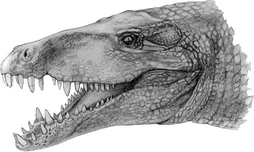Description

A possible life restoration of Sebecus
Sebecus icaeorhinus was a large crocodylomorph from Eocene, South America. This creature had a laterally compressed skull which gave it's head an unusual appearance. Sebecus was a carnivore that fed on the small, still evolving mammals in the large, humid jungles of the Eocene. It grew up from 2 metres long to 3.1 metres long and would have weighed from between 50 to 120 kg. It's height would have been less than a metre but it did not need to be since there were no really large herbivores that required long, strong limbs like some of the later crocodylomorphs like Pristichampsus had.
Discovery
Sebecus was first discovered by Florentino Ameghino in 1906 when some teeth that were thought to belong to theropods were found in Patagonia. In 1937 George Gaylord Simpson made some further discoveries of some skull and jaw fragments and named the genus Sebecus and the species he found icaeorhinus thus Sebecus icaeorhinus was truly born. In 1965 and 1991 some supposed new species of Sebecus were found and named Sebecus huilensis and Sebecus querejazus. These were later found to be distant species of crocodylomorph.
Etymology

The fearsome jaws of Sebecus
The name Sebecus comes from the latinisation of the crocodile god Sobek of ancient egypt. Sobek was considered the alternative because ''Champsa'' was claimed by a greek historian to be the egyptian word for crocodile and the greek word for crocodile is ''suchus''. Champsosaurus already existed so Sebecus was made. The species name icaeorhinus comes from the greek word Εικαίοs meaning "confused" or ''unplanned'' and ρύγχος means "snout", in reference to the creatures's deep rostrum.
Paleobiology
The skull of Sebecus would have allowed it to withstand great pressure when closing the jaws due to its long, narrow, strong skull that was reinforced at the base giving it an extremely considerable bite force. This

Life restoration of its unusually shaped skull
suggested that it was a carnivore that ate most of its kill when it made one. It might also hint at a life more suited to scavenging but scavengers don't need large, serrated teeth for eating rotting flesh so it was most likely an active carnivore. It's method of hunting would have been that of an ambush hunter because despite being adept on land and living in a place that required it to be, it was still a reptile that had a cold-blooded lifestyle so its would have kept a low, hidden profile near some water then when a potential prey item came near it would run out with explosive power and run a few hundred metres during which it would hopefully catch its prey.